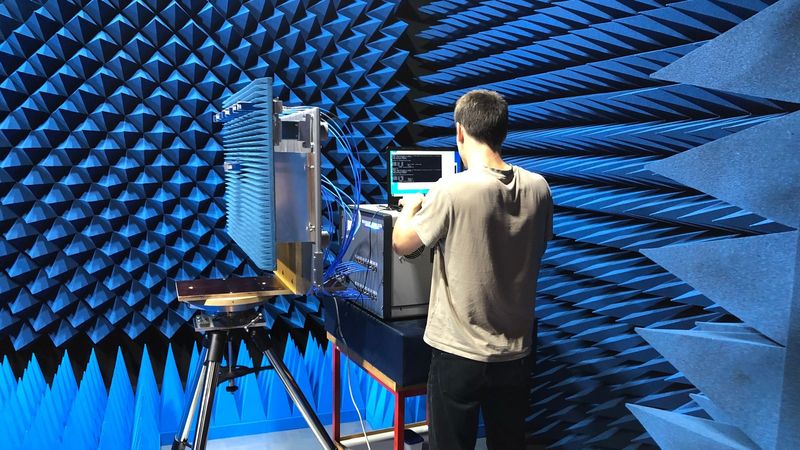New radar system can detect drones
Researchers from DTU Space have developed a new type of high-resolution radar that looks in many directions concurrently.

A new type of high-resolution radar developped at DTU Space looks in many directions concurrently. Photo: Lasse Lehmann, DTU.
It takes a radar out of the ordinary to catch a drone in flight. It is even harder to detect a drone that is hovering in the same place, because it quickly disappears in the background noise. But a new radar system—developed by researchers from DTU Space in collaboration with the Danish company Terma—can do both and more to boot.
The radar has a high resolution and a wide field of vision, and it can track many drones simultaneously. Drones are otherwise difficult to spot, because they can be tiny and come from all directions. Moreover, they are often made of plastic materials that do not reflect radar waves very well.
“There is a large market for detecting drones, for example in military contexts and at airports,” says Professor Jørgen Dall from DTU Space, who heads the radar project. He also mentions the problems that the Swedish authorities have had with illegal drone flights. Especially at the beginning of 2022, drones were repeatedly observed over nuclear power plants, military areas, airports, and royal palaces.
To avoid accidents at airports, protect critical infrastructure, and keep military secrets, etc., there are many places where drones are not allowed to fly. The first step towards combating illegal drone flying is to detect, track, and preferably also classify the drone. And here the new radar can help.
Many antennas provide higher resolution
In general, a radar works by emitting a microwave signal that is reflected by an object, and the echo is then picked up and compared with the outgoing signal. Knowing that the signal moves at the speed of light, it is easy to calculate the distance to the object. You just have to measure how long it has been under way.
This is easy in theory, but it is more difficult in the real world, especially if you want to know not only the distance to an object, but also its exact position in three dimensions, as well as its speed. But here the researchers from DTU Space exploit the great advantage of having a radar which has not just one antenna that is used to send and receive signals, but instead a total of 16 antennas.
The principle of using multiple antennas is called MIMO, which stands for multiple-input multiple-output. The principle is especially known from wireless communication, where the advantage is first and foremost to ensure a high bandwidth.
Without MIMO technology in the latest WiFi standards and mobile networks (4G and 5G), the speed of data transfer to and from the laptop and mobile phone would be somewhat lower than it is today. The DTU researchers set out to examine whether the technology with multiple antennas can also be used to improve radar systems, and this turned out to be the case.
Works without rotating
"With MIMO, we can see in all directions concurrently within a fairly wide angle range—for example 120 degrees—and we can get a good horizontal angle resolution in a relatively low-cost way without rotating the radar,” says Jørgen Dall and continues:
“Our radar has eight transmitters and eight receivers. If all the transmitters sent the same signal at the same time, we would just get one large antenna sending a signal in a specific direction, but, instead, we make sure that the transmitters either send the same signal in a staggered manner or send different signals.”
"Each of the eight signals is collected and separated from each other by all eight receivers, which gives us 64 virtual channels in total, even though we only have 16 physical channels.”
When a drone is hit by a signal from a transmitter, the signal is reflected back to all eight receivers, and—based on the timing of the echo—the distance and direction to the drone can be calculated. But with eight transmitters and receivers positioned in just the right way relative to each other, the position and speed of the drone can be determined much more accurately.
Range may be increased
If the drone is close, it even becomes possible to identify the type. So-called micro-doppler signatures—which are caused by the movements of the rotor blades—can reveal what type of drone it is.
The radar project has been running since 2018 and has now resulted in a demonstration model that clearly shows that the concept works. Another MIMO radar is being built.
The range of the prototypes is just 100 metres, because a longer range requires higher power, a transmission permit from the authorities, as well as somewhat more expensive amplifiers. Initially, the project focused on showing that the technology can be used, and the range can easily be increased in later versions.
Jørgen Dall also emphasizes that MIMO radars can be used for other purposes than detecting small, flying objects. The primary purpose of the project is to conduct research into radar technology, and drone detection was an appropriate application in this connection.
The project will continue with two PhD students attached and a third on the way, and it is primarily funded through a grant of DKK 5.8 million from the Thomas B. Thrige Foundation.
If Terma chooses to continue with the technology for actual product development and commercialization of MIMO radars, it is possible that these systems will contribute to protection of airport security against threats from the ground as well as the air, as a competence extension to Terma’s airport radars worldwide.